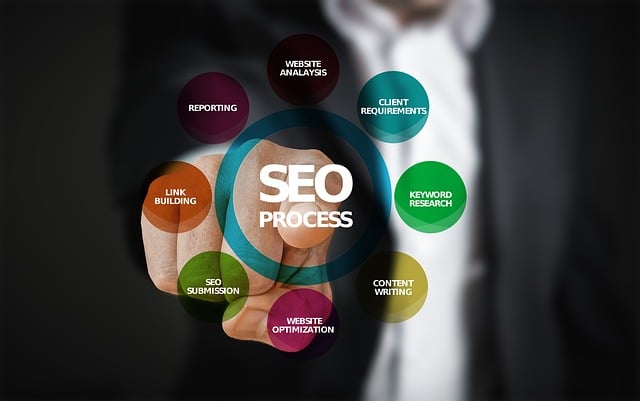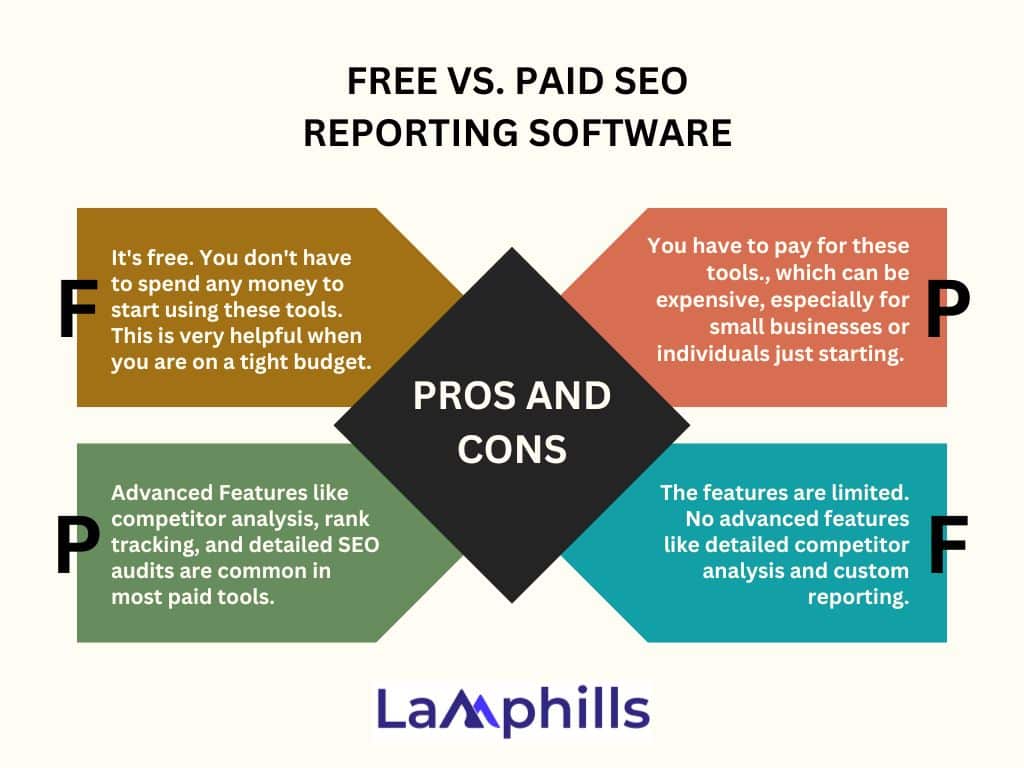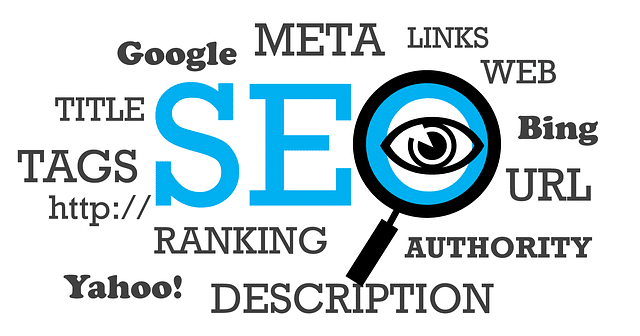Hey! Are you also scratching your head, trying to decide between free vs. paid SEO reporting software? Then you’re reading the right article. In this post, your doubts about whether it’s better to buy paid tools or stick with free SEO software will be cleared up.
Generally, no one wants to spend a lot of money on expensive and advanced SEO tools that they might not get good results from or find hard to use. However, when choosing between free and paid SEO reporting software, it’s important to consider what features you need and your budget.
This article will explore the differences between free and paid options to help you decide which is right for you.
Key Points
- Free tools offer basic functions for beginners. While paid tools offer advanced features for serious SEO efforts.
- Free tools are good for small websites and beginners. While paid tools are necessary for detailed reports and growing businesses.
- Free tools provide basic performance tracking. While paid tools provide detailed insights and competitor analysis.
- Free tools offer limited customer support. While paid tools provide direct, comprehensive customer support.
- Paid tools provide better integration, support for business growth, and customizable reports.
Free vs. Paid SEO Reporting Software- Understanding Basic Terms

Image by Pixabay
When discussing SEO reporting software, we usually come across two types: free and paid. Understanding their basic differences can help you choose the right type for your needs.
Free SEO Reporting Software: This software can be used without paying money. Free tools are perfect for individuals or small businesses just starting with SEO. They offer basic functions like tracking keywords, analyzing backlinks, and checking your website’s performance. These tools are easy to use and don’t cost anything, making them great for anyone looking to boost their website’s visibility on search engines.
While free tools can be a great starting point, they might not meet the needs of more complex projects or growing businesses. This article will examine these disadvantages and more.
Paid SEO Reporting Software: Paid SEO tools are more comprehensive and have features essential for deep SEO analysis and planning. They provide extensive data tracking, detailed analyses of keywords, checks on competitors, and advanced reporting tools. Users of paid tools also get regular updates, more accurate data, and professional customer support to help solve problems or improve usage.
These tools are better for businesses ready to invest seriously in their online presence and who need detailed information to attract more visitors, climb higher in search rankings, and ultimately increase earnings.
When I first started in online marketing, SEO was very confusing. There were many things to learn about keywords, backlinks, and optimizing web pages. One of the biggest challenges was finding the right tools to track my progress. I spent many nights comparing different SEO reporting software, trying to choose between free and paid options. With time, I learned a lot about these tools, including what these tools can and cannot do, and I’m excited to share that with you.
Free vs. Paid SEO Reporting Software: Understanding Your Needs
Before picking a tool, you need to understand what you need. Are you a small business owner just starting out, or are you part of a larger team with more complex needs?
Free software can be a good start for beginners or small websites. It lets you see basic information about your site’s activities without spending money. However, if you need more detailed reports or special features to help your website perform better, you might need to choose paid software. Paid SEO tools offer more advanced options and better support to help you manage your website’s performance more effectively. So, consider your website needs and how much you can spend to make the best choice.
When I first started, I needed to track keyword rankings, monitor backlinks, and analyze website traffic. However, with time, I needed more advanced features like competitor analysis and detailed technical audits as the business expanded.
Free Vs. Paid SEO Reporting Software: Basic Features

Image by Vicki Hamilton from Pixabay
When choosing between free vs. paid SEO reporting software, it is important to look closely at the basic features they both offer.
Paid software, on the other hand, offers more detailed features. It can give you deeper insights, such as detailed reports on your website traffic, tips for improving your pages, and tools to analyze your competition more closely. While free tools are good for beginners or those with a tight budget, paid tools are better for those who need more in-depth information and are ready to invest in better results.
Read Also: SEO Reporting Tools for Agencies: A Comprehensive Guide
Here’s a more detailed explanation comparing both features:
#1. Features
Free software usually provides essential tools that help you see how your website is doing. You can check which keywords bring people to your site and how high your site ranks on search engines. These tools might show where your website appears in search results and suggest small improvements.
Paid SEO reporting software, on the other hand, provides a wider range of features. These tools can give you more detailed information about your website, like which keywords are bringing in visitors, detailed reports on improving your site, and tools to monitor your competitors. This helps you make more informed decisions to improve your website’s visibility and performance.
#2. Data Quality and Detail
When choosing between free and paid SEO reporting software, one key difference is the quality and detail of the data they provide. For Free Software, the data might not be very detailed or updated often. For instance, keyword rankings may not be very current, and you might only be able to track a few keywords.
Paid software provides more detailed and accurate data, with updates coming more frequently and the ability to track more keywords and competitors.
#3. Customer Support

Image by Gerd Altmann from Pixabay
When comparing free and paid SEO reporting software, customer support is one major feature to look for.
Free SEO software often has limited customer support. This means that if you run into problems or have questions, you might have to rely on online forums, help articles, or community help, which can take longer and might not solve your specific issue.
Paid SEO software, on the other hand, usually offers much better customer support. This can include direct help from the company through phone calls, emails, or live chat. Access to quick and personal help can make using the software effectively and solve problems easier.
For instance, Support for free software is often limited to community forums or basic FAQs, while paid Software usually includes better support options like live chat, email help, dedicated managers, and thorough guides or training.
#4. Integration and Growth
Regarding free versus paid SEO reporting software, integration, and growth are two big points to consider.
Integration means how well the software works with other tools you use. Free SEO tools are usually basic and might not connect smoothly with other software, which can be a hassle if you’re trying to look at all your data in one place. On the other hand, paid SEO tools often offer better integration. This means they can easily work with other tools, helping you see everything more clearly and make better decisions.
Growth refers to how the software can help your website or business improve. Free tools might be okay when starting out because they’re simple and don’t cost anything. But as your business grows, you might find that these tools don’t do everything you need. Although more expensive, paid SEO tools usually offer more features and are better suited to support your business as it expands. They can give you deeper insights and more detailed reports to help you improve your website.
#5. Customization and Reports

Image by Mohamed Hassan from Pixabay
Also, free SEO reporting software and paid SEO reporting software differ in customization and the types of reports they offer. Usually, the free tools provide basic reports. These are good enough if you’re just starting out or if you only need simple information. However, you might be unable to change these reports much to fit your needs.
You often get more detailed reports if you pay for SEO reporting software. You can also customize these reports to show exactly what you need. This is great if you have specific requirements or if your website needs a deep analysis to understand how to improve.
Note: if you want more control over your reports and need detailed information, paid SEO software might be the way to go. But free software can still be a good choice if you’re okay with basic information and less customization.
#6. Cost Effectiveness
Never ignore pricing considerations when choosing between free and paid SEO reporting software.
Free SEO Software: This is a great choice if you have a small budget or are just starting out. Free tools don’t cost anything, but they might not have all the features that the paid ones do. They can still provide helpful basic information to improve your website.
Paid SEO Software: If you’re willing to spend some money, paid SEO tools can offer more detailed and powerful features. They might give you deeper insights into how your website is performing and more specific suggestions for improving it. This can be very helpful if you’re serious about improving your website and are okay with investing money for potentially greater returns.
#7. Larger Databases
When comparing free and paid SEO reporting software, one of the big differences is in their databases. Paid SEO tools usually have larger databases. This means they can provide more detailed and extensive information about things like keywords, backlinks, and competition. This extra data can be very helpful if you want to improve your website’s ranking on search engines. On the other hand, free tools might have smaller databases, which can still be useful but might not offer as much detailed information.
#8. Training and Resources
Another important factor to consider when choosing between free and paid SEO reporting software is the training and resources they offer.
Free SEO Reporting Software: Often, free tools provide basic help and resources. This might include general guides or community forums where you can ask other users for advice. However, you usually won’t get personalized training or support.
Paid SEO Reporting Software: Paid tools often come with more detailed help. This can include one-on-one training sessions, detailed manuals, and dedicated customer support teams. These resources can help you understand and use the software effectively, especially when dealing with complex SEO tasks.
So, if you need more hands-on help and detailed guidance, paid SEO tools might be a better choice. But free tools might be enough if you’re comfortable figuring things out independently or have simpler needs.
#9. Regular Updates

When you use SEO reporting software, it’s important to have the latest features to keep up with changes in how search engines rank websites. Free SEO tools might not update often, so they might not have the latest features or the most current data. Paid SEO tools usually update regularly, giving you access to new tools and better information to help your website perform well in search results. With paid tools, you’ll likely have the newest improvements and support to help you manage your SEO effectively.
Your choice between free and paid SEO reporting software should depend on your specific needs, budget, and how important SEO is to your marketing. Free tools are great for getting started without spending money, but paid tools provide deeper insights, more features, better support, and the ability to grow with your business, which is important for serious SEO efforts.
Here’s a comprehensive checklist to help you compare and choose between free and paid SEO tools.
Free vs. Paid SEO Reporting Software- Pros and Cons
When choosing SEO (Search Engine Optimization) reporting software, you can choose between free and paid versions. Each option has its advantages (pros) and disadvantages (cons). Let’s look at these to help you decide which type of software might be right for you.
Free SEO Reporting Software: Pros and Cons
Pros:
1. Cost: It’s free. You don’t have to spend any money to start using these tools. This is very helpful when you are on a tight budget.
2. Basic Features: Free tools have important features like keyword tracking, backlink analysis, and traffic reports, which are great for beginners or small websites.
3. Easy to Use: Tools like Google Analytics are user-friendly, and many online tutorials and guides are available.
Cons:
1. Limited Features: As my needs grew, I found that free tools couldn’t do everything I wanted. They often lack advanced features like detailed competitor analysis and custom reporting.
2. Data Limits: Free tools like Ahrefs and SEMrush limit how much data you can use.
3. Support and Updates: Free tools usually offer limited customer support and slower updates.
Paid SEO Reporting Software: Pros and Cons

Using paid tools was a big step up for me. The first time I used SEMrush, I was amazed by the data available. Tools like Ahrefs, Moz, and SEMrush offer many advanced features that can really improve your SEO strategy.
Pros of Paid Tools:
1. Detailed Data: Paid tools provide deep insights into keyword rankings, backlinks, site audits, and more.
2. Advanced Features: Features like competitor analysis, rank tracking, and detailed SEO audits are common in most paid tools.
3. Customization: The ability to create custom reports tailored to specific metrics was very helpful for my growing business.
4. Support and Resources: Premium tools often include excellent customer support, regular updates, and many learning resources.
Cons of Paid Tools
1. Cost: The main downside is the cost. You have to pay for these tools. High-quality SEO tools can be expensive, with monthly fees ranging from $100 to $500 or more, which can be expensive, especially for small businesses or individuals just starting out.
2. Complexity: With more features comes more complexity. Sometimes, these tools can be harder to use, and you might need to spend time learning how to make the most of them.
Carefully weigh the pros and cons of each option to find the best fit for your website’s needs.
Free vs. Paid SEO Reporting Software- Examples
One time, during a major website update, I used free tools to track changes, but the data wasn’t enough. After upgrading to SEMrush, I could see detailed reports of on-site health, backlink profiles, and keyword movement. This helped me make informed decisions and recover quickly from any SEO problems.
Read Also: 10 Best SEO Reporting Tools I Have Used for Analytics and Performance Insights
When considering SEO reporting software, looking at specific examples of free and paid options is also useful. Here are some well-known tools in each category:
Examples of Free SEO Reporting Software:
#1. Google Analytics
I have a friend who runs a small online bookstore. They used Google Analytics to identify which social media platforms drove the most traffic to their site. By focusing on these platforms for their marketing efforts, they saw a 30% increase in traffic over three months.
Google Analytics helps you understand who is visiting your website, how they found you, what they did on your site, and whether they completed any desired actions, like making a purchase or signing up for a newsletter.
It’s perfect for anyone starting a website. You can see basic information without spending money, which is great for small businesses, bloggers, and even larger companies that need to track website performance.
#2. Google Search Console
This tool shows you how your website appears in Google’s search results. It tells you about problems that might keep your site from showing up properly, like errors that prevent Google from reading your site correctly, and it shows which terms people searched for to find your site.
It is ideal for website owners who want to ensure their site is Google-friendly and can be easily found by people using Google search.
#3. Ubersuggest (Free Version)
As a content writer, I often use Ubersuggest’s free version to find keywords that are performing well. This helps me make my articles more visible for topics related to what I write about.
Ubersuggest provides basic tools for finding words or phrases people use in searches (keywords), analyzing your website to suggest improvements, and analyzing your competitors’ activities.
This tool is useful for small business owners or freelance workers who need some help with SEO but aren’t ready to invest in expensive tools. It gives good initial insights without costing anything.
Examples of Paid SEO Reporting Software
#1. SEMrush
SEMrush is a more comprehensive tool that thoroughly examines your site. It checks how well your site is set up for search engines (site audits), helps you find good keywords, and shows how you compare to competitors.
This tool is best for SEO professionals and businesses that are serious about online marketing. They often need detailed reports and are willing to pay for top-notch tools.
#2. Ahrefs
Here at Lamphills, we use Ahrefs to monitor and improve clients’ backlink profiles. By targeting high-quality links, one client moved up from page three to the first page on Google for competitive terms, leading to a significant increase in leads.
Ahrefs is known for its powerful tools for analyzing the links coming to your site from other sites (backlinks). It also helps with researching keywords, checking your site for problems, and planning what content to write.
This is great for content creators and marketers who are focused on getting links from other sites that need an in-depth analysis of their SEO strategies. It’s a bit pricey but very powerful for those who need its advanced features.
#3. Moz Pro
Moz Pro includes several helpful SEO tools, such as tools to help you find the right keywords, check your site for SEO issues, and provide tips on improving individual pages.
Who should use it: Businesses and SEO professionals who want reliable tools for regular checks and updates on their SEO status will find Moz Pro very useful. It’s good for monitoring your SEO efforts on an ongoing basis.
Each of these tools has its strengths and is designed to help different kinds of users. Free tools are great for getting started and understanding the basics, while paid tools offer deeper insights and more complex features for those who are more experienced in SEO.
Wrap Up
In conclusion, both free and paid SEO reporting software have benefits. Free tools are great for starting out and understanding the basics, while paid tools are essential for growing and gaining a competitive edge.
If you’re just starting, don’t hesitate to use free tools, they can provide a solid foundation. But as your business grows, be ready to invest in paid tools to unlock your SEO potential fully.
Bonus Answer to FAQs.
Is SEO free or paid?
Technically, it’s free. You don’t pay to get ranked on search engines. Google and others use algorithms to rank websites, and you don’t pay them to be included. You can do many important SEO tasks yourself, like making your website content better and improving user experience.
How to Pick SEO Software?
To pick the best SEO software for your business, consider all these factors to make the right choice.
– Your business goals
– Your budget
– Technical skills
– Website Platform
– Keyword research features
– On-page optimization tools
– Link building tools
– Local SEO features
– How well it integrates with other marketing tools
– Customer support options
Which free SEO tool is best for beginners?
Here are some great free SEO tools:
1. Google PageSpeed Insights
2. Ahrefs Webmaster Tools
3. Answer the Public
4. Google Analytics
5. Google Search Console
6. Ahrefs’ Backlink Checker
7. Google Ads Keyword Planner
8. SERP Snippet Optimization Tool
Is paid SEO worth it?
Yes, it’s worth it! SEO brings in more visitors and builds trust than paid ads, which usually cost much more per click.
What type of SEO is best?
White hat SEO techniques are the best way to improve your SEO ranking over time. These are the methods that Google suggests you use to help your site rank better in search results. They follow Google’s rules and bring positive results for your business.
Similar Articles
Take Your Content Reporting To The Next Level With These Tips
What Is an SEO Manager: How to Become One, Skills, Jobs and Salary
My SEO Workflow: A Comprehensive Guide to Boosting Your Search Rankings






